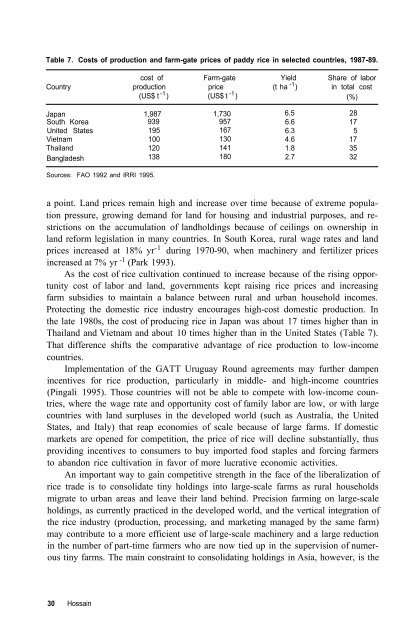Sustainability of rice in the global food system - IRRI books
Sustainability of rice in the global food system - IRRI books
Sustainability of rice in the global food system - IRRI books
Create successful ePaper yourself
Turn your PDF publications into a flip-book with our unique Google optimized e-Paper software.
Table 7. Costs <strong>of</strong> production and farm-gate p<strong>rice</strong>s <strong>of</strong> paddy <strong>rice</strong> <strong>in</strong> selected countries, 1987-89.<br />
cost <strong>of</strong> Farm-gate Yield Share <strong>of</strong> labor<br />
Country production p<strong>rice</strong> (t ha -1 ) <strong>in</strong> total cost<br />
(US$ t -1 ) (US$ t -1 )<br />
(%)<br />
Japan 1,987 1,730 6.5 28<br />
South Korea 939 957 6.6 17<br />
United States 195 167 6.3 5<br />
Vietnam 100 130 4.6 17<br />
Thailand 120 141 1.8 35<br />
Bangladesh 138 180 2.7 32<br />
Sources: FAO 1992 and <strong>IRRI</strong> 1995.<br />
a po<strong>in</strong>t. Land p<strong>rice</strong>s rema<strong>in</strong> high and <strong>in</strong>crease over time because <strong>of</strong> extreme population<br />
pressure, grow<strong>in</strong>g demand for land for hous<strong>in</strong>g and <strong>in</strong>dustrial purposes, and restrictions<br />
on <strong>the</strong> accumulation <strong>of</strong> landhold<strong>in</strong>gs because <strong>of</strong> ceil<strong>in</strong>gs on ownership <strong>in</strong><br />
land reform legislation <strong>in</strong> many countries. In South Korea, rural wage rates and land<br />
p<strong>rice</strong>s <strong>in</strong>creased at 18% yr - 1 dur<strong>in</strong>g 1970-90, when mach<strong>in</strong>ery and fertilizer p<strong>rice</strong>s<br />
<strong>in</strong>creased at 7% yr -1 (Park 1993).<br />
As <strong>the</strong> cost <strong>of</strong> <strong>rice</strong> cultivation cont<strong>in</strong>ued to <strong>in</strong>crease because <strong>of</strong> <strong>the</strong> ris<strong>in</strong>g opportunity<br />
cost <strong>of</strong> labor and land, governments kept rais<strong>in</strong>g <strong>rice</strong> p<strong>rice</strong>s and <strong>in</strong>creas<strong>in</strong>g<br />
farm subsidies to ma<strong>in</strong>ta<strong>in</strong> a balance between rural and urban household <strong>in</strong>comes.<br />
Protect<strong>in</strong>g <strong>the</strong> domestic <strong>rice</strong> <strong>in</strong>dustry encourages high-cost domestic production. In<br />
<strong>the</strong> late 1980s, <strong>the</strong> cost <strong>of</strong> produc<strong>in</strong>g <strong>rice</strong> <strong>in</strong> Japan was about 17 times higher than <strong>in</strong><br />
Thailand and Vietnam and about 10 times higher than <strong>in</strong> <strong>the</strong> United States (Table 7).<br />
That difference shifts <strong>the</strong> comparative advantage <strong>of</strong> <strong>rice</strong> production to low-<strong>in</strong>come<br />
countries.<br />
Implementation <strong>of</strong> <strong>the</strong> GATT Uruguay Round agreements may fur<strong>the</strong>r dampen<br />
<strong>in</strong>centives for <strong>rice</strong> production, particularly <strong>in</strong> middle- and high-<strong>in</strong>come countries<br />
(P<strong>in</strong>gali 1995). Those countries will not be able to compete with low-<strong>in</strong>come countries,<br />
where <strong>the</strong> wage rate and opportunity cost <strong>of</strong> family labor are low, or with large<br />
countries with land surpluses <strong>in</strong> <strong>the</strong> developed world (such as Australia, <strong>the</strong> United<br />
States, and Italy) that reap economies <strong>of</strong> scale because <strong>of</strong> large farms. If domestic<br />
markets are opened for competition, <strong>the</strong> p<strong>rice</strong> <strong>of</strong> <strong>rice</strong> will decl<strong>in</strong>e substantially, thus<br />
provid<strong>in</strong>g <strong>in</strong>centives to consumers to buy imported <strong>food</strong> staples and forc<strong>in</strong>g farmers<br />
to abandon <strong>rice</strong> cultivation <strong>in</strong> favor <strong>of</strong> more lucrative economic activities.<br />
An important way to ga<strong>in</strong> competitive strength <strong>in</strong> <strong>the</strong> face <strong>of</strong> <strong>the</strong> liberalization <strong>of</strong><br />
<strong>rice</strong> trade is to consolidate t<strong>in</strong>y hold<strong>in</strong>gs <strong>in</strong>to large-scale farms as rural households<br />
migrate to urban areas and leave <strong>the</strong>ir land beh<strong>in</strong>d. Precision farm<strong>in</strong>g on large-scale<br />
hold<strong>in</strong>gs, as currently practiced <strong>in</strong> <strong>the</strong> developed world, and <strong>the</strong> vertical <strong>in</strong>tegration <strong>of</strong><br />
<strong>the</strong> <strong>rice</strong> <strong>in</strong>dustry (production, process<strong>in</strong>g, and market<strong>in</strong>g managed by <strong>the</strong> same farm)<br />
may contribute to a more efficient use <strong>of</strong> large-scale mach<strong>in</strong>ery and a large reduction<br />
<strong>in</strong> <strong>the</strong> number <strong>of</strong> part-time farmers who are now tied up <strong>in</strong> <strong>the</strong> supervision <strong>of</strong> numerous<br />
t<strong>in</strong>y farms. The ma<strong>in</strong> constra<strong>in</strong>t to consolidat<strong>in</strong>g hold<strong>in</strong>gs <strong>in</strong> Asia, however, is <strong>the</strong><br />
30 Hossa<strong>in</strong>

















